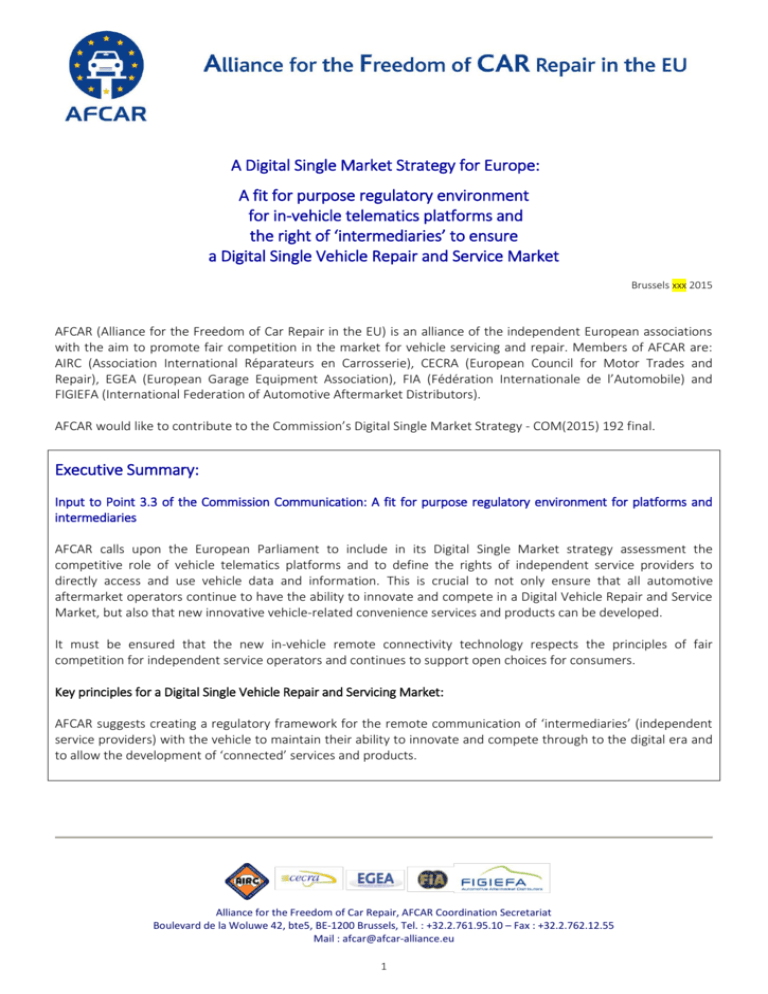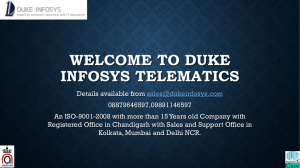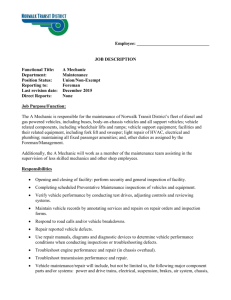A Digital Single Market Strategy for Europe: A fit for purpose
advertisement

A Digital Single Market Strategy for Europe: A fit for purpose regulatory environment for in-vehicle telematics platforms and the right of ‘intermediaries’ to ensure a Digital Single Vehicle Repair and Service Market Brussels xxx 2015 AFCAR (Alliance for the Freedom of Car Repair in the EU) is an alliance of the independent European associations with the aim to promote fair competition in the market for vehicle servicing and repair. Members of AFCAR are: AIRC (Association International Réparateurs en Carrosserie), CECRA (European Council for Motor Trades and Repair), EGEA (European Garage Equipment Association), FIA (Fédération Internationale de l’Automobile) and FIGIEFA (International Federation of Automotive Aftermarket Distributors). AFCAR would like to contribute to the Commission’s Digital Single Market Strategy - COM(2015) 192 final. Executive Summary: Input to Point 3.3 of the Commission Communication: A fit for purpose regulatory environment for platforms and intermediaries AFCAR calls upon the European Parliament to include in its Digital Single Market strategy assessment the competitive role of vehicle telematics platforms and to define the rights of independent service providers to directly access and use vehicle data and information. This is crucial to not only ensure that all automotive aftermarket operators continue to have the ability to innovate and compete in a Digital Vehicle Repair and Service Market, but also that new innovative vehicle-related convenience services and products can be developed. It must be ensured that the new in-vehicle remote connectivity technology respects the principles of fair competition for independent service operators and continues to support open choices for consumers. Key principles for a Digital Single Vehicle Repair and Servicing Market: AFCAR suggests creating a regulatory framework for the remote communication of ‘intermediaries’ (independent service providers) with the vehicle to maintain their ability to innovate and compete through to the digital era and to allow the development of ‘connected’ services and products. Alliance for the Freedom of Car Repair, AFCAR Coordination Secretariat Boulevard de la Woluwe 42, bte5, BE-1200 Brussels, Tel. : +32.2.761.95.10 – Fax : +32.2.762.12.55 Mail : afcar@afcar-alliance.eu 1 This means enshrining the right of direct access to data/information and of “online” communication (“capacity to read and write”) with the digital telematics platform in the vehicle through standardised, interoperable and secure interfaces. The macro-sectorial perspective: Industrial equipment using ‘digital’ repair The same principles hold true for any industrial equipment or investment goods, which need servicing and repair over their entire life-time, which are controlled by a computer and are nowadays more and more connected remotely to a maintenance server (e.g. industrial equipment such as 3-D printers, lifts, household applications). 1. The ‘connected car’ – The AutoCare Industry ‘goes digital’ As outlined in the Commission’s DSM Communication, digital technologies are transforming the lives we lead and the way we work. This is also true for the entire value chain of vehicle spare parts, test tools, servicing and repair – the so-called ‘Aftermarket’ (or: AutoCare Industry). The multi-brand automotive value chain alone employs 3.5 million people in over 500.000 companies servicing 260 million motorist consumers every day. Wireless telematics technologies are rapidly becoming part of the new evolution of modern vehicles. The (smart) ‘connected car’ is about to change the way we drive and think about our personal mobility. New vehicle technologies support safety functionalities such as emergency assistance (eCall) and also breakdown assistance (bCall), but can also provide a wide-ranging array of entertainment and information services, such as route navigation, traffic information, e-mail, web browsing, social media, hotel bookings, or directions to the nearest available parking space or petrol station. These services and the ability of the car to interface with other connected devices means that the vehicle is increasingly becoming a part of our daily ‘connected-mobility’. The insertion of the telematics systems and functionalities in the vehicle servicing sector will be exponentially increased with the mandatory introduction of ‘eCall’, when all new vehicles must be equipped with an automatic in-vehicle emergency call system as from 2018 onwards. This will significantly affect the way in which the entire aftermarket service chain operates. It must be ensured that this new technology respects the principles of fair competition and open choice for consumers and independent service operators. 2 2. Digitalisation of vehicle repair and maintenance: The dashboard as the new customer relation interface and point of sale At present, in-vehicle telematics platforms are technically designed in a proprietary way that only allows vehicle manufacturers to have direct access to the vehicle and its data. These platforms have the capacity to generate and accumulate an enormous amount of data about the (health) status of the vehicle or how repair services can be rendered more efficiently, or what new services can be developed and offered to the customer (e.g. online predictive remote diagnostics to ideally avoid breakdowns). As a result, the current telematics platforms provide vehicle manufacturers with a privileged information advantage (information monopoly) which enables them to offer exclusive online services to the customer and to control (i.e. eventually prevent) the development of vehicle-related online services and products by competitors for which data are needed1. Direct impact on fair competition, independent SME service providers’ ability to innovate and compete to support free consumer choice All this prevents equal access by independent SME service providers and limits their ability to innovate and compete ‘online’ on an equal footing. It ultimately limits consumers’ freedom of choice between competitive repair/maintenance and other consumer convenience services. 3. Spill-over to other markets: The car as ‘online shop on wheels’ While this alone would already be a disadvantage for the customer who can no longer choose between competitive ‘online’ services in the field of car repair and maintenance, the effect of these proprietary platforms even spills over to other markets, because information technology doesn’t stop at a local or market border. The car’s dashboard will undoubtedly become a new point of sale for all kinds of products and services, and unless regulated, the current controller of the data (vehicle manufacturers) will be the one that who and profits from the offers provided to the customer. Vehicle manufacturers and their telematics platforms have the potential to become players competing advantageously in many sectors of the economy, for example by offering of tailor-made insurance services; guiding customers to the hotel/restaurant/petrol station network chosen by the vehicle manufacturer; offering special life-style products/services over the dashboard (e.g. when being delayed in a traffic jam). 1 Some vehicle manufacturers have started to offer ‘open’ systems, but only to selected business-model partners. Moreover, these still impose proprietary communication and access requirements that are unique for each vehicle model, making it impossible for independent operators to create practical and economic applications across a range of vehicles. 3 4. AFCAR proposals for a Digital Regulatory Environment AFCAR calls upon the European Parliament to include in its Digital Single Market strategy assessment the competitive role of vehicle telematics in-vehicle platforms and to define the rights of independent service providers to be able to directly access and use vehicle data and information. This is crucial to ensure that all automotive aftermarket market players continue to have the ability to innovate and compete in a Digital Vehicle Repair and Service Market, but that also new service providers may offer new innovative vehicle-related convenience services and products. To ensure that the targets of a European Digital Single Market are met, fair and open access to in-vehicle data and information along with an appropriate degree of standardisation must be mandated by European legislation. This will ensure that the entire automotive industry sector (including the AutoCare Industry value chain) can maintain its competitiveness and even expand its position as a job creator and a field of technical excellence for highly skilled Digital Entrepreneurs. 4.1. Key principles for a regulatory environment for telematics platforms and the right of intermediaries in the Digital Single Automotive Repair and Service Market AFCAR suggests creating a regulatory framework for the remote communication of ‘intermediaries’ (independent service providers) with the vehicle to maintain their ability to innovate and compete also in the digital era and to allow the development of ‘connected’ services and products. This means enshrining the right of direct access to data/information and of online communication (“capacity to read and write”) with the digital telematics platform in the vehicle through standardised2, interoperable and secure interfaces. AFCAR invites the European Parliament to enshrine this key principle into its Digital Single Market assessment to ensure that vehicle repair markets remain open and competitive. 4.2. The macro-sectorial perspective: Key principles for industrial equipment using ‘digital’ repair While the amount of time and money spent servicing and maintaining a vehicle throughout its lifetime is significant, the same principles applies to many other products which are connected to a computer, in that it connects the “thing” to the internet. Typically these are industrial equipment or investment goods, which need servicing and repair over their entire life-time, which are nowadays more and more remotely connected to a digital platform/a maintenance server, for example: Industrial 3-D printers 2 Standardisation and the definition of interoperability requirements are needed to ensure a level playing field for independent service providers and to avoid a “monopolisation through the technical backdoor”. Standardisation and interoperability requirements are the prerequisite for enabling the economically viable development of multi-brand services, applications or products. Without standardisation, the development of new products or services would be uneconomic, and the market would remain fragmented, once again reducing competition and decreasing the opportunity for innovation and competition. Standardisation and interoperability is possible and achievable, demonstrated by EU funded research and currently discussed in the C-ITS Platform, a forum run by the Commission discussing the technical requirements. 4 Industrial PCs and industrial equipment (e.g. refrigeration) Lifts House applications (e.g. home heating) Construction equipment Faced with a monopolistic control over data and information, independent service providers will be forced out of the market, and consumers/businesses will be forced to sign restrictive contracts with the respective original manufacturers to allow access to these products. Access to the information that connected devices provide through monopolistically-controlled systems as well as the functionalities now possible (software solutions, next service proposals, replacement part recommendations) is becoming the most important factor in the market, rather than innovation, service, or quality. Because these platforms are often designed and operated by large enterprises, innovative SMEs need robust regulation to ensure a level playing field, which guarantees fair competition, price-, service- and qualitycompetition and innovation which create jobs and allows EU SMEs to hold and expand their ground against international competition. **** SIgnatures NEODVISNI POPRODAJNI TRG multi-brand avtoserviserji pomoč na cesti POPRODAJNI TRG predstavlja VERIGO PONUDNIKOV STORITEV, ki so v pomoč lastnikom/uporabnikom vozil Ponudniki dostopa do tehničnih informacij proizvajalci delov prodajalci delov proizvajalci orodij 5









